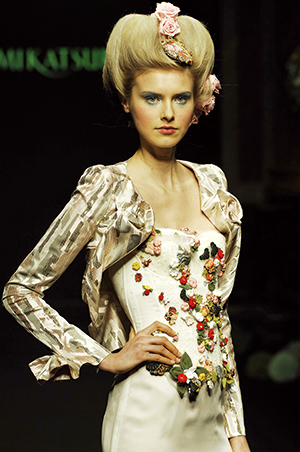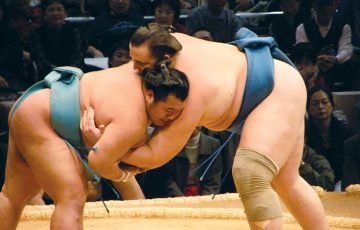 In Paris’ ultra-chic First Arrondissement, 26 Rue Cambon is an address that represents the culmination of one young girl’s dreams Ð fantastic and beautiful dreams that began at a time when the world was enveloped in death and destruction.
In Paris’ ultra-chic First Arrondissement, 26 Rue Cambon is an address that represents the culmination of one young girl’s dreams Ð fantastic and beautiful dreams that began at a time when the world was enveloped in death and destruction.
Only a stone’s throw from fashionable Place Vendome and across the street from a Chanel boutique, bridal designer Yumi Katsura opened her own store at that address in 2005. Of course, Katsura has been a big fish on the wedding scene for a good deal longer Ð the opening merely affirmed her well-established position as one of the world’s foremost dress designers even more. But looking all the way back to her beginnings in war-stricken Japan, it also serves as a tangible reminder of just how far she’s come.
“When I was little, I loved fairy tales,” she recalls, taking a moment to pause in a lace-adorned room inside her eye-catching seven-story Bridal House in Tokyo’s Nogizaka district. “Even before the war started, Japan was moving toward militarism and things were bloody. In that kind of environment, more and more I wanted to live in a dreamy world.”
She may no longer be a spring chicken, but there is something about her that seems ageless, as though she were still that same little girl enraptured by comforting fables like the Cinderella and Snow White stories she says she loved.
“Then when I was in my second year of junior high school, Japan lost the war,” Katsura continues. “Until then we believed we were going to win and we looked up to the soldiers, but all of that disappeared very suddenly. Tokyo was completely in ruins; there were black markets and homeless kids on the streets, thieves and ugliness everywhere. Nothing good or beautiful existed. So I tried to escape from reality.”
The young Yumi found the outlet she needed in drama classes and threw herself into acting completely. But while she was trying to avoid reality, her mother was trying to change it for Japanese women.
At a time when the only suitable place for a woman was still thought to be the home, her mother managed a fashion school and taught dressmaking in an attempt to educate her students about financial independence while providing a skill they could perform without leaving the house.
Growing up surrounded by fashion, Katsura had little enthusiasm for it Ð partly because she didn’t have a knack for sewing and partly because, she says, “young people have a natural resistance to following in their parents’ footsteps.”
Things changed Ð as they often do Ð once she reached university and discovered that one can be a designer with little need to pick up a needle and thread. After obtaining a degree from Kyoritsu Women’s University’s Department of Apparel Science Studies, she was nearly ready to let her creativity flourish. But what really pushed her transformation into a maven of bridal style was her first trip to France just after graduation. Although Paris is an almost commonplace destination for young Japanese nowadays, it was no small feat when Katsura made her debut journey there to study the techniques of haute couture at the source.
“You cannot imagine it now,” she says whimsically. “There were 300 students at the airport to see me off. Some of them were crying and some had signs with messages such as ‘congratulations on your trip to France!’
“When I got there, I felt like it was a totally different world. I went back and forth between where I stayed and my school, just trying to absorb things as much as possible. What I saw connected with the fantasy world I always dreamt of when I was a little girl.”
Breaking Ground
 Katsura’s Nogizaka flagship location seems just as connected to that fanciful world Ð unabashedly so. The Bridal House, christened in 1975, not only had a huge aesthetic impact on the area at the time, but it also did wonders to reinforce the corporate image of her growing wedding empire. Her dresses are displayed in the midst of fairytale trimmings, in rooms that perhaps every girl has dreamed of at least once in her life. Considering the building’s unique appearance, it’s no wonder that over the years it has become a true landmark Ð much like Yumi Katsura herself, who is nothing short of a pioneer in her field.
Katsura’s Nogizaka flagship location seems just as connected to that fanciful world Ð unabashedly so. The Bridal House, christened in 1975, not only had a huge aesthetic impact on the area at the time, but it also did wonders to reinforce the corporate image of her growing wedding empire. Her dresses are displayed in the midst of fairytale trimmings, in rooms that perhaps every girl has dreamed of at least once in her life. Considering the building’s unique appearance, it’s no wonder that over the years it has become a true landmark Ð much like Yumi Katsura herself, who is nothing short of a pioneer in her field.
Japan has adopted Ð or at least tried to mimic Ð many different aspects of Western culture over the years, but weddings certainly seem to take the cake when it comes to borrowing traditions. But it wasn’t always that way, at least not until Katsura came along and essentially blazed a trail for a Western-style wedding business in this country. Her efforts even earned her the nickname, “Missionary of Bridal.”
While teaching dressmaking, it came to her attention that not only did many young Japanese seamstresses dream of making wedding gowns, And yet, says Katsura, “when I started this business in 1964, about 97 percent of Japanese couples married in Kimono. I never could have imagined so many people would choose wedding dresses like they do now.”
Today, only about a third of all Japanese couples choose to take their vows in traditional Shinto fashion. Many of the rest opt for ringing chapel bells, bouquet tosses, English-speaking ministers Ð a fair share of whom aren’t even real men of the cloth Ð and, of course, a gorgeous white dress.
What started as one of the first businesses of its kind in Japan has grown into an empire, boasting annual gross sales of around ´13 billion. Katsura has four boutiques under her direct control and her franchises now total 70, with locations around the world. Yearly, more than 30,000 brides wear her wedding dresses.
“We held the first wedding dress show in Japan,” she explains, referring to the 1965 event she organized at Tokyo’s Hotel New Otani. “At the time, however, everyone was saying, ‘wow, it’s beautiful’ Ð but that’s all. It was only something for them to look at. Now people who come to our shows think ‘I want to wear that one!’”
The novelty of being the first might be enough to satisfy some, but to this day Katsura continues to push the creative envelope while combining substance with style. Taking advice gleaned from her studies in Paris, she says that what she pays attention to most is “to be elegant, always. That’s what they taught us, over and over.”
In the early 1980s, she made her first foray into the US market with a showing of her bridal-wear collection in New York. This was a seminal event in more ways than one, serving as a springboard to expansion into numerous overseas markets, but also giving her a chance to display ideas that would prove highly influential on the bridal design industry as a whole. These included the adoption of a technique giving dresses a “3D” effect with deeper texture, a so-called sweetheart neckline and the use of a stiffener to create a floating hem, among other innovations.
She would go on to hold shows in more than 20 cities spanning the globe, producing dresses for celebrities, garnering an award from the Committee of European Excellence and even producing a special vestment for Pope John Paul II, which the pontiff wore on Easter Sunday in 1993.To produce such a significant body of work surely requires constant sources of inspiration and for this, she says, she draws on three essential ingredients.
“First, I think I look to nature,” Katsura explains. “Mainly flowers or the ocean.”
Secondly, it’s the raw material Ð the fabric. “Fabric makers hold conventions twice a year in Paris. Sometimes I give them requests or ask for new materials, and when I see new elements, ideas for designs just come to me.”
But the third component might just be the most important: “My clients, the brides themselves.”
After all, what is more special Ð or more beautiful Ð than a bride on her wedding day? Even noted French dress designer Pierre Balmain was jealous of Katsura’s ability to dedicate herself completely to bridal design, whereas he only got the chance to make a wedding gown a few times a year. “He said to me: ‘I think the most beautiful thing in this world is a bride in a wedding dress. I envy you because you get to design it all the time.’”
It is this appreciation for those who actually don her creations that, even at her lofty perch atop the industry, Katsura still relishes every chance she gets to meet brides face-to-face and offer them advice. “I give them my opinions about tiaras and flowers. And when I see a couple, if they have a gap in their heights, I suggest things like putting the veil little bit higher.”
These guidance sessions are something she gets to participate in about four times a year, in between an amazing juggling act of obligations that include design, management and material-finding expeditions. Still, somehow she miraculously manages to find a bit of time for herself as well, in the form of activities such as swimming and scuba diving. Even then, work is never far from her mind.
“My doctor tells me to go to the pool,” she says. “When I’m in water, good and fresh ideas come up to my mind, so even (though) it’s my day off I get excited and call the office to explain my thoughts to the staff.
“I really enjoy my job,” she adds with a smile. “It’s fun for me.”
That’s Haute!
 Many consider participation in haute couture Ð literally, high dressmaking Ð to be the pinnacle of a career in the fashion industry. It involves making specifically made-to-order, singular garments of the highest quality, as opposed to pret-a-porter (ready-to-wear) designs that are never one of a kind and are often mass-produced. Showing a collection at Paris’ twice-annual haute couture events is a chance to unveil one’s finest artistic creations for the entire world to see. Although it’s not a big income earner, top designers still take part in this sort of work, almost as a matter of principle. It gives their labels a prestigious aura, to be sure, but more importantly it provides them with the chance to express their creativity to its fullest extent.
Many consider participation in haute couture Ð literally, high dressmaking Ð to be the pinnacle of a career in the fashion industry. It involves making specifically made-to-order, singular garments of the highest quality, as opposed to pret-a-porter (ready-to-wear) designs that are never one of a kind and are often mass-produced. Showing a collection at Paris’ twice-annual haute couture events is a chance to unveil one’s finest artistic creations for the entire world to see. Although it’s not a big income earner, top designers still take part in this sort of work, almost as a matter of principle. It gives their labels a prestigious aura, to be sure, but more importantly it provides them with the chance to express their creativity to its fullest extent.
“Haute couture is like the essence of myself,” says Katsura. “It’s a condensed form of what gushes out of me, what I really want to make. That’s haute couture.”
Katsura made her first appearance at the Paris Haute Couture Collection in January 2003, showing dresses meant to express the traditional Japanese sense of beauty. She has been a fixture on the scene ever since, showing at both the Spring/Summer and Fall/Winter displays. It is yet another connection to the City of Light for this lady of small stature but big ideas, her career intrinsically woven with her Parisian experiences. It’s understandable, then, why opening a store in the French capital would mean so much to her.
“Paris is the first foreign city I visited, and it’s also where I learned many things,” she says thoughtfully. “And so I feel like I have accomplished my goal as a designer by opening a shop and having the brides in the city wear my dresses.”
Mission accomplished or not, she is showing no signs of slowing down. Asked about her thoughts on the future of bridal design, one can almost see the wheels turning in her mind.
“The age range is getting wider nowadays Ð even I got married when I was 42,” she explains. “Body shapes vary as well. And people will always ask for different concepts. It’s more interesting for creators now, because (when I started) there weren’t many styles. Everything looked the same.”
Brides of the future rejoice: more of Yumi Katsura’s works of art appear to be on the way and she seems determined to come up with plety of ideas we’ve yet to see, let alone imagene.
Story by Kayo Yamawaki
From J SELECT Magazine, September 2007















Recent Comments